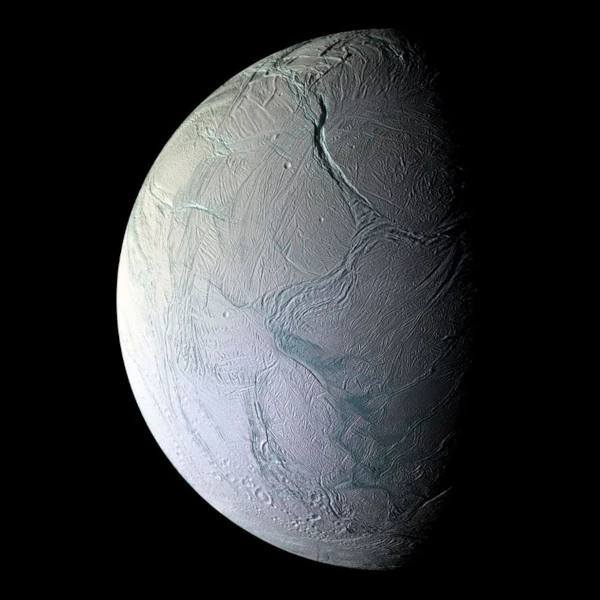
Few moons in our solar system are as captivating as Enceladus. While several icy worlds are thought to harbor liquid water beneath their frozen shells, Enceladus actively ejects its ocean into space, where spacecraft can sample it.
Enceladus, Saturn’s sixth-largest moon with a diameter of 504 km, was discovered in 1789 by astronomer William Herschel (1738–1822). This icy world orbits Saturn at 238,000 km in just 1.37 days, experiencing intense tidal forces that keep its interior active. The Cassini mission (2004–2017) revealed in 2005 that vapor and ice particles were erupting from its south pole, making Enceladus one of the most geologically active bodies in the solar system.
These plumes, emitted through four large parallel fractures nicknamed the "tiger stripes" (Baghdad Sulcus, Damascus Sulcus, Cairo Sulcus, Alexandria Sulcus), contain water, salts, organic molecules, and even nanoscopic silica grains. These suggest hydrothermal interactions between liquid water and the rocky core at temperatures >90°C.
Data from Cassini confirmed in 2015 the existence of a global subsurface ocean 10–30 km deep, beneath a 20–30 km ice shell. This ocean is kept liquid by:
It may contain up to 107 km3 of salty water (similar in salinity to Earth’s oceans). Gravitational measurements show the ocean is in direct contact with the silicate core, enabling complex chemical exchanges.
Analyses of the plumes by Cassini’s INMS spectrometer identified:
The simultaneous presence of H2, CO2, and CH4 suggests methanogenesis processes similar to those in Earth’s hydrothermal vents. The estimated pH (8.5–10.5) and temperature (0–90°C) are compatible with extremophile microbial life.
Three main scenarios explain Enceladus’ formation:
Enceladus’ surface features diverse terrains:
Several missions are planned to study Enceladus:
These missions will use next-generation instruments such as:
| Moon | Diameter (km) | Ocean Depth (km) | Estimated Temperature (°C) | Habitability Index | Exploration Mission |
|---|---|---|---|---|---|
| Enceladus | 504 | 10–30 | 0 to 90 | 0.85 | Cassini (2004–2017), Orbilander (proposed) |
| Europa | 3,122 | 80–170 | -20 to 50 | 0.78 | Juice (ESA), Europa Clipper (NASA) |
| Titan | 5,151 | 200–300 (subsurface) | -180 to -50 | 0.65 | Dragonfly (2027) |
| Ganymede | 5,262 | 100–200 (multiple layers) | -120 to 0 | 0.55 | Juice (ESA) |
Sources: NASA - Enceladus Overview, Waite et al. (2017) - Nature, Hsu et al. (2015) - Nature (H2 detection), ESA - Juice Mission.